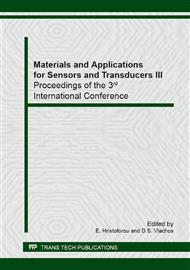p.173
p.177
p.181
p.185
p.189
p.194
p.198
p.202
p.207
Differentiating among Gas Mixtures Using a Single Tin Oxide Gas Sensor
Abstract:
Despite all their positive features oxide-based resistive gas sensors are nonselective and respond similarly for different gas and gas mixtures. The authors have recently demonstrated that the response patterns generated by a generic tin oxide gas sensor induced by thermal shocks contain considerable amounts of information regarding the nature of the present gas. Here, the results of using a similar technique on different two-component gas mixtures are reported. The gas mixtures are (1-butanol)x (2-butanol)1-x, (1-propanol)x (2-butanol)1-x, (1-butanol)x (1-propanol)1-x, and (1-butanol)0.33 (2-butanol)0.33, (1-propanol)0.33, each at various total concentrations. The diagnostic features of the response patterns were extracted, by applying wavelet transform, and used for their discrimination in a three dimensional feature space. The positions of the clusters related to different gases are consistent with their composition and facilitate estimating the individual concentrations of the components.
Info:
Periodical:
Pages:
189-193
Citation:
Online since:
April 2014
Authors:
Price:
Сopyright:
© 2014 Trans Tech Publications Ltd. All Rights Reserved
Share:
Citation:


